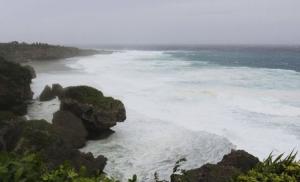
There are no nuclear plants on
Okinawa but there are two on Kyushu, which lies in the area through
which the typhoon is likely to pass after hitting Okinawa. There is
another on Shikoku island, which borders Kyushu and could also be
affected.
All are shut down due to national policy and the
Fukushima Daiichi nuclear plant, which was wrecked by an earthquake and
tsunami in March 2011, is on the other side of the country. "When the wind blows most strongly, it's impossible to stand. You have to hold on to something," said Kei Shima, a self-employed Okinawa resident in her 30s.
"The lights are fading in and out, like the house is haunted. The rain is getting stronger and falling sideways."
Neoguri was roughly 110 km (68 miles) southwest of Kumejima of island at noon (0300 GMT) and moving north at 25 kph (16 mph), with sustained winds of 180 kph (110 mph).
Kadena Air Base, one of the largest U.S. military facilities on Okinawa, was on its highest level of storm alert and all outside activity was prohibited.
Nansei Sekiyu KK, a Japanese refiner wholly owned by Brazil's Petrobras, said it had suspended oil refining operations at its 100,000 barrels-per-day Nishihara refinery in Okinawa on Monday evening.
A JMA official said the storm will maintain its strength as it heads north but gradually turn to the east, making landfall in Kyushu before raking its way up the main island of Honshu and coming close to Tokyo on Friday.
"But it will be weaker by then, so that Tokyo can mainly expect a lot of rain, and maybe some gusts of wind," he added.
Around two to four typhoons make landfall in Japan each year but they are unusual in July.
(Additional reporting by Oliver Fabre,; Editing by Nick Macfie)
0 comments:
Post a Comment